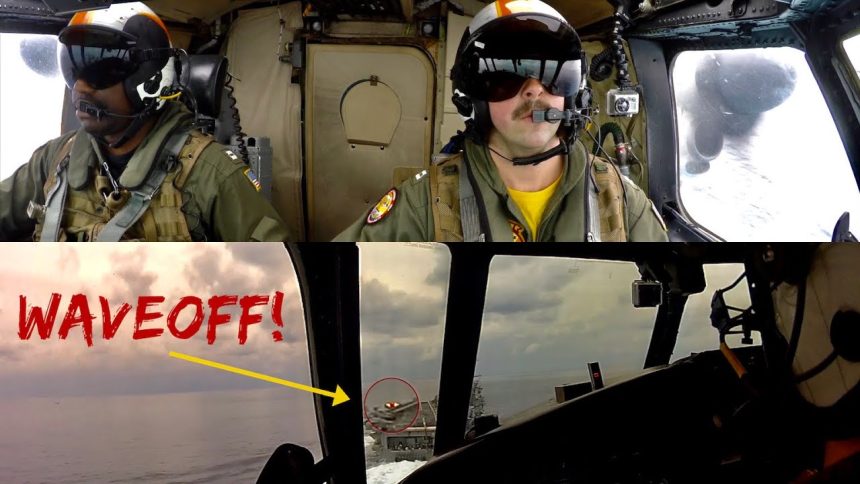Split screen footage shows Navy C-2A Greyhound performing bolter, waveoff and trap landing on USS Harry S. Truman aircraft carrier in the Persian Gulf.
A couple of weeks ago we published a video showing the trap landing of a C-2A(R) Greyhound of the Fleet Logistics Support Squadron 40 (VRC-40) “Rawhides” aboard USS Harry S. Truman aircraft carrier in the Persian Gulf. The split screen footage started with the COD aircraft approaching the carrier in the VFR pattern and then showed the overhead break, the downwind leg, the base turn for the final approach “into the groove” and the arrested landing.
Pretty cool, but also pretty standard, at least compared to the a new video the same pilot, Rob Roy, has recently posted to Youtube.
The new footage, uploaded on Nov. 15, 2020, but filmed “a few years back”, shows a more “complicated” arrival to the USS Truman once again in the Persian Gulf, in the 5th Fleet AOR (Area Of Responsibility): the COD aircraft performs a bolter (i.e. fails to catch a wire after touchdown), is waved off (i.e. is instructed to perform a go around) on the second attempt and then finally carries out a successful trap landing.
As some of the Youtube viewers noticed, the bolter was probably caused by the C-2 landing a bit long (watch the “meatball” centered then climbing as the aircraft passes the ramp). On the second pass, the Greyhound appears to be a little fast out of the base turn then went high in the middle of the approach: when the LSO (Landing Signal Officer) deemed the aircraft too high for a safe landing, he/she instructed the pilot to add full power and go around using the Optical Landing System (OLS), also known as the “meatball” or simply “ball”. The red flashing lamps you can clearly see in the footage are a mandatory command for the pilots to perform a missed approach and try again. The third pass was a successful trap landing.
VRC-40 is a United States Navy fleet logistics support squadron based at NS Norfolk. It is one of only two active fleet logistics squadrons in the Navy, the other being VRC-30. Both Squadrons support aircraft carriers at sea across the world.
As already explained in this previous feature:
The Grumman C-2A Greyhound is a twin-engine, high-wing cargo aircraft, designed to perform the COD (Carrier Onboard Delivery) mission: it carries equipment, passengers (including occasional distinguished visitors) supplies and mail to and from U.S. Navy aircraft carriers.
Initially scheduled to be retired in 2027, the C-2A(R) will be eventually retired in 2024, when the last squadron is expected to phase out the Greyhound. The U.S. Navy is getting 39 CMV-22 out of 58 Ospreys included in a 4.2B USD contract signed by the Pentagon in 2018 to fully replace the C-2 fleet. The first operational CMV-22B Osprey configured for the COD role was delivered to the U.S. Navy on June 22, 2020. The aircraft, registration #169437, is assigned to Fleet Logistics Multi-Mission Squadron 30 (VRM-30) “Titans” at Naval Air Station North Island. The Titans are the first CMV-22B squadron that was stood up in December 2018, a year before the first flight of the “CODsprey” (as some nicknamed the new aircraft), and they will receive 18 aircraft in total.
On Nov. 22, 2020, a CMV-22B tilt-rotor aircraft of the Fleet Logistics Multi-Mission Squadron 30 (VRM-30) “Titans” at Naval Air Station North Island conducted the first ever Navy COD (Carrier On-board Delivery) variant of the Osprey landings and take-offs from an aircraft carrier (USS Carl Vinson).









